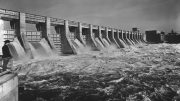New research from Florida tracks carbon dioxide and methane emissions from human-created waterways.
With sand and muck trickling out of her equipment and ferocious Floridian Sun scorching her canoe, Audrey Goeckner was about ready to give up on her research project and possibly even her University of Florida Ph.D. The freshwater ecosystem ecologist was gathering data on Florida’s stormwater ponds using a piston corer, a metal tube that can be plunged into soft sediment to gather samples. As she raised the corer, the sand would mix with the muck layered atop it, ruining her measurement. Plus, each effort required a paddle back to the pond’s bank, and she was growing tired.
Eventually, Goeckner prevailed, quantifying carbon sequestration and emissions at five Tampa Bay area ponds with similar landscape conditions and ages ranging from 14 to 34 years. Goeckner and other researchers gathered four to six sediment samples per pond to measure the capture of organic carbon and measured gas flux biweekly during a 10-month period. They discovered that although carbon sequestration rates increased with age, the ponds were still a net carbon source because of relatively high levels of carbon dioxide and, to a lesser extent, methane emissions. Their study was published in Communications Earth and Environment.
Shifting Landscapes and Mindsets
Stormwater ponds are artificial features created to collect rainwater and, in some regions, melted snow. They protect the quality of nearby waterways by containing sediment, which sinks to the bottom of the ponds, and prevent erosion by limiting runoff. Often included in commercial and residential developments, Goeckner noted that there are now more than 76,000 ponds in Florida alone.
“People might not think that stormwater ponds are anything other than a hole in the ground with water, but there’s so much more going on underneath the surface,” she said. “It’s really important to take a look at how these built ecosystems play a role in how elements move through the landscape.”
Goeckner said it’s common for natural and artificial waterways to be carbon sources, not sinks. It’s not shocking that the ponds—which capture fertilizer runoff, lawn clippings, and other organic matter—might be subject to the effects of the decomposition of those organic materials. But she hopes her research will help developers and community leaders account for the impact of stormwater ponds.
“It’s easy for developers to build [stormwater ponds] and then not think about what other changes come along with them,” Goeckner continued, noting “they might play a pretty big role in carbon or the cycling of other elements.”
“I don’t want anybody to think of stormwater ponds as bad. If anything, I want people to look at stormwater ponds and consider, ‘Wow, what is going on in the water?’”
Since the study was published, Goeckner has chatted with local lake managers about how practices such as dredging, aeration, and stocking fish can influence carbon emissions. She encourages scientists to consider stormwater ponds in regional and global carbon models.
Goeckner has also raised ire among those who believe she’s against stormwater ponds. She isn’t.
“I don’t want anybody to think of stormwater ponds as bad. If anything, I want people to look at stormwater ponds and consider, ‘Wow, what is going on in the water?’” she said.
Methane Measurements Raise Questions
Despite the prevalence of stormwater ponds, their relationship with carbon cycling is poorly understood. Past studies measured greenhouse gas emissions or carbon burial rates but rarely combined the two, as Goeckner did. In addition, stormwater ponds are often located on private lands, where they are managed variably, so it’s been difficult to quantify their impact on carbon cycles or the environment.
Although this study has added data about the role of stormwater ponds, freshwater ecologist Meredith Holgerson said the findings also showed a puzzlingly low level of methane emissions. One possible reason is that Goeckner and her colleagues measured diffusive gas flux, which tracks methane mixed into water but not ebullient methane, which could bubble up from sediment.
“To predict if a water body is going to have more diffusive fluxes or more ebullitive fluxes is still something we can’t do yet,” said Holgerson, who was not involved with the publication. But measuring all methane released by stormwater ponds could help make precise calculations of greenhouse emissions associated with human-made ponds.
Holgerson applauded the Florida study’s nearly year-round measurements and also hopes to see similar measurements in more variable, seasonally diverse climates. One first step that could help, Holgerson said, is for other states to follow Florida’s lead and track the total number of stormwater ponds.
“For ponds naturally, globally, we have no idea” how many there are, she said. “There are estimates between 500 million on the low end and 3 billion on the high end.”
By Robin Donovan @RobinKD
June 22, 2022
Oiginally published by Eos Science News by AGU





